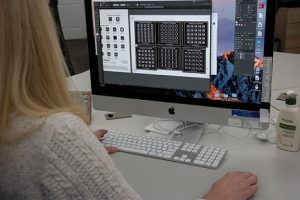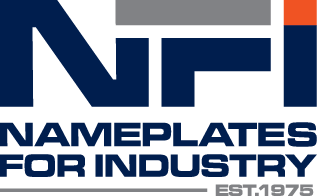Follow these custom label art specifications when submitting graphic files to NFI for your labels, nameplates, faceplates, overlays, membrane switches, and other graphic solutions.
We accept all versions of Adobe Illustrator, Adobe Photoshop, Adobe InDesign, Corel Draw files up to version 8 , and Quark XPress files up to version 8.
Note: We do not accept Microsoft Word, Microsoft Publisher or Visio Files as Artwork.
Artwork that is created using vector artwork software such as Freehand, Illustrator and Corel Draw are typically preferable to bitmap images, such as JPEG and GIF files. NFi asks all clients to read the following section on Art Criteria for more information.
General
Please see the table above for a list of software programs that are acceptable by NFi for the creation of electronic artwork.
Please provide a clearly-defined, high-quality black-and-white or color composite example of your artwork. PDF files are a preferred method for you to use to convey to us your expectations via email. However, we are unable to use PDF files to create the art necessary for producing your order. If you are only able to send us a fax, please make sure to mark all of your specifications clearly, including details such as colors and measurements.
Please do not send email files that are larger than 10MB. Consider using a compression application program, such as WinZip for Windows or Stuffit for Mac, to compress large files before sending via email.
Art Criteria
Before you send any electronic art files to Nameplates For Industry, please review the following information about fonts, design, dimensions, general artwork information and how to submit files to NFi.
Fonts
Please send both screen and printer fonts for any Type 1 fonts that you send to Nameplates For Industry with your order. Remember to also include any fonts that were used in placed graphics, especially in EPS files.
The minimum thickness for type for screenprinting is 4 point. Typefaces that are considered “lightweight”, “extra bold” or “black” should not be used at this size.
Design
Make sure to include extra area in your artwork for bleeds. When you have graphics that bleed off the edge of the label, add an eighth of an inch outside the dimension and bleed out to that area.
All of your artwork should fit proportionately and evenly inside your desired label size.
Make sure to keep in mind that large graphics may contain lines that will be too thin when the image is reduced down to finished size.
Line thickness for printing should be a minimum of .007 or .5 point.
The distance the artwork should be kept from the edge of labels or the “cutting tolerance,” should be at least .060″.
Bleed borders should be avoided all together if possible, but if they are absolutely necessary, the border should be at least .09″.
Avoid using inset borders whenever possible. Again, if they are absolutely necessary, the border must be inset at least .09″ for all the edges.
All clear windows and LEDs should have a black border of at least .016″ to facilitate trapping of background colors during production.
Dimensions
Make sure to include all dimensions for size and placement on your drawings. This is important because electronic files can move images. Include an accurate hard copy with all the measurements to ensure that tolerances are met for holes, cutouts, graphics and placement of images and text in your artwork.
Submit Files
Please provide us with artwork in the format that it was originally created, such as Adobe Illustrator (.ai), Corel Draw (.dwg), Adobe PhotoShop (.psd) or Macromedia Freehand (.fh8), so we can provide you with the best possible reproduction of your artwork or logo.
It is important for you to convert all of your text to paths. If you learn how to submit files to NFi and do this before you send us your artwork, font conflicts will be avoided. An option is available in the Type menu in vector artwork software, such as Freehand or Illustrator, that allows you to convert fonts to paths.
All imported graphics should be included with your original source file. Do not use web graphic formats, such as JPEG or GIF files, whenever possible. JPEG and GIF are very common file formats, however there are some drawbacks to using these formats in print production. They do not create the best print image because they are typically created for use on web pages or other on-screen applications. The JPEG format compresses the image data by reducing the number of colors in the file, diminishing the quality of the created graphic compared to the original artwork. The GIF format creates a file that only contains a maximum of 256 colors, which can also greatly affect the quality of the artwork.
Bitmap images should be saved as 300ppi CMYK images. Please provide a file that is twice the size of the final printed product – 200 percent larger – especially if the finished product will be less than 2 inches in size.
Art Proofs
Clients are invited to mail, fax or email art proofs to Nameplates For Industry. Emailed art proofs will be provided to clients in the Adobe PDF format. If you do not have Adobe’s free PDF reader installed on your computer, just visit www.Adobe.com to download.
Make sure to also include your email address when you place an order. We will need your email address to send your art proofs back to you via email.
